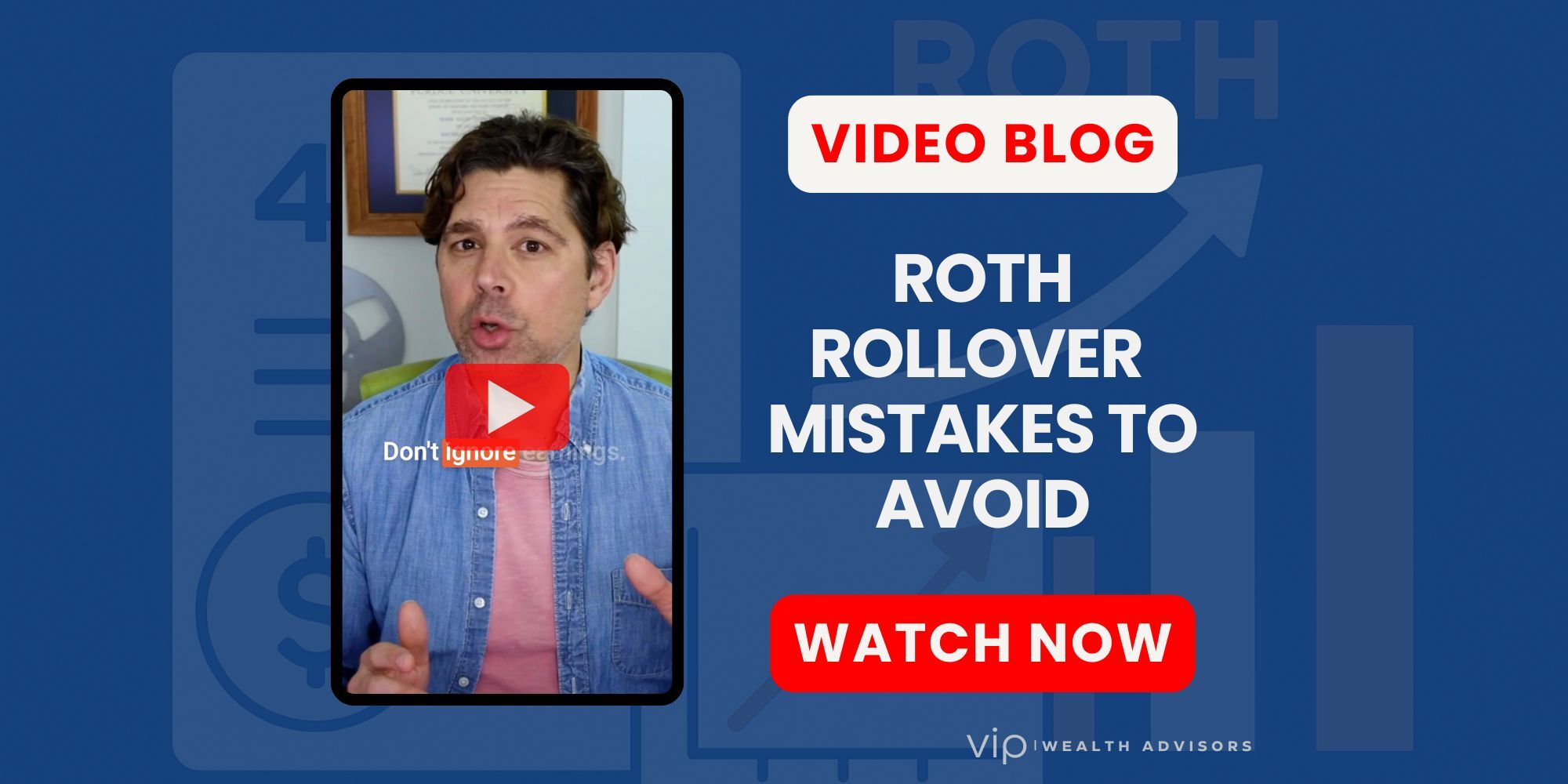Roth Rollover Pitfalls: What High-Income Professionals Need to Know
Let me guess: you’ve maxed out your 401(k), your income disqualifies you from direct Roth IRA contributions, and someone mentioned that your plan allows “after-tax” contributions beyond the limit. Sounds like a Roth workaround, right?
Not so fast.
This is one of the most misunderstood corners of retirement planning. If you confuse after-tax 401(k) contributions with Roth 401(k) contributions, or if you mess up the rollover process, you could trigger thousands of dollars in unnecessary taxes.
Let’s break this down in plain English. Whether you’re a tech exec, a startup founder, or a high-income professional with money to stash away, this guide will help you avoid costly mistakes and make the most of your 401(k) options.
What Are After-Tax 401(k) Contributions?
Once you’ve maxed out your employee deferral limit ($23,500 in 2025), some plans allow you to continue contributing after-tax dollars up to the total annual plan limit (which is $70,000 in 2025 if you're under 50).
That extra room can be massive. But here’s the problem:
After-tax 401(k) dollars are not the same as Roth 401(k) dollars.
Let’s break it down:
| Feature | After-Tax 401(k) | Roth 401(k) |
|---|---|---|
| Contributions | Made with after-tax dollars | Made with after-tax dollars |
| Earnings | Tax-deferred, taxed at distribution | Tax-free if qualified |
| Withdrawal Rules | Contributions tax-free, growth taxable | Contributions and growth tax-free if qualified |
| Conversion Options | Can be rolled into Roth IRA or Traditional IRA | Already in Roth account |
The mistake? People assume after-tax 401(k) money acts like Roth money. It doesn’t. The contributions come out tax-free, but the growth is taxed as ordinary income on distribution.
Why This Matters: The Pro Rata Rule (Explained with Math)
Here’s where the IRS rules trip people up — and why sloppy execution can trigger a surprise tax bill.
Let’s say your 401(k) contains a mix of different contribution types:
- $150,000 pre-tax contributions (traditional deferrals and employer match)
- $30,000 after-tax contributions
- $20,000 of earnings on those after-tax contributions
Your total account balance is:
$150,000 (pre-tax)
+ $30,000 (after-tax contributions)
+ $20,000 (earnings)
= $200,000 total
Now, let’s say you try to roll over just $30,000 to a Roth IRA, thinking you’re only moving the after-tax contributions and there’s no tax owed.
But here’s the IRS rule:
Any partial distribution from a 401(k) must come out in the same proportion as the entire account balance.
So, we calculate the ratios in your account:
- Pre-tax ratio: $150,000 / $200,000 = 75%
- After-tax ratio: $30,000 / $200,000 = 15%
- Earnings ratio: $20,000 / $200,000 = 10%
Now, apply those percentages to the $30,000 distribution:
| Type | % of Account | % of Distribution | Dollar Amount |
|---|---|---|---|
| Pre-tax | 75% | 75% | $22,500 |
| After-tax | 15% | 15% | $4,500 |
| Earnings | 10% | 10% | $3,000 |
| Total | 100% | 100% | $30,000 |
If you send that $30,000 to a Roth IRA, here's what happens:
- The $4,500 after-tax portion goes in tax-free (you already paid taxes on it).
- The $22,500 pre-tax and $3,000 earnings portions are now considered a taxable Roth conversion — and will be taxed as ordinary income.
That’s $25,500 of unexpected taxable income in the year of the rollover.
Ouch.
How to Do It Right: The Split Rollover Strategy
Fortunately, there’s a correct way to do this — and it’s a massive opportunity when executed properly.
Here’s the play:
- Roll the pre-tax portion of your 401(k) into a Traditional IRA (or better yet, into your new employer’s 401(k) if they allow roll-ins).
- Roll the after-tax contributions into a Roth IRA.
- Earnings on the after-tax portion (if any) must be rolled into the Traditional IRA — they are considered pre-tax.
Using our earlier example:
- $150K goes to a Traditional IRA
- $30K goes to a Roth IRA (no tax)
- $20K of earnings go to the Traditional IRA (tax-deferred)
Result: You just moved $30K of after-tax money into a Roth IRA, where it can now grow tax-free, and you avoided the pro rata tax mess.
Even Better: Mega Backdoor Roth (If Your Plan Allows)
If your 401(k) plan allows in-service distributions or in-plan Roth conversions, you may not even need to leave the plan to get the benefit.
This is known as the Mega Backdoor Roth, and it’s one of the best-kept secrets in retirement planning for high-income earners.
How it works:
- Contribute after-tax dollars to your 401(k) beyond the $23,000 limit.
- Convert those after-tax contributions to the Roth 401(k) immediately (before they generate earnings).
- Your money is now growing tax-free inside the plan.
No pro-rata issues. No taxable events. Just clean, efficient Roth funding.
What NOT To Do
Let’s make this simple. If you see yourself in any of the examples below, you’re playing with fire:
❌ You try to roll over only after-tax 401(k) dollars to a Roth IRA without doing a full distribution.❌ You ignore the earnings on after-tax contributions, which are taxable if converted.
❌ You forget that all Traditional IRAs are aggregated under the pro rata rule — even if you’re just converting the non-deductible part.
❌ You assume your plan allows after-tax contributions without checking the fine print.
❌ You think “after-tax” and “Roth” are interchangeable.
Each of these mistakes can lead to unintended tax bills — and they’re surprisingly common.
Backdoor Roth Conversions: Another Pro Rata Trap
Let’s not confuse this with the 401(k) strategy, but it’s worth mentioning here: the Backdoor Roth IRA also triggers the pro-rata rule.
If you make a non-deductible contribution to a Traditional IRA and then convert it to a Roth, the IRS checks all your IRA balances to determine how much of the conversion is taxable.
If you have $100K in pre-tax IRAs and only $7K of after-tax, your conversion will be 93% taxable.
How to fix it: Roll those pre-tax IRA balances into a 401(k) before doing the conversion. Employer plans aren’t included in the pro rata calculation.
How to Know What Your Plan Allows
Before you make any moves, you need answers to a few questions:
- Does your 401(k) plan allow after-tax contributions? (Not all do)
- Can you make in-service withdrawals of those after-tax dollars?
- Does the plan support in-plan Roth conversions?
- Does the plan track after-tax contributions separately from earnings?
If the answer to any of those is “no,” your strategy needs to be adjusted.
The Big Picture: Why This Matters
For high-income earners, Roth space is precious.
You’re likely phased out of contributing directly to a Roth IRA. You’re already maxing out your 401(k). You’ve exhausted the usual playbook.
But if your plan allows it, after-tax 401(k) contributions paired with smart rollover execution or Mega Backdoor Roth strategy give you a way to build significant tax-free wealth.
And in retirement, when RMDs kick in and you’re trying to manage tax brackets, having a Roth bucket can be a game-changer.
Final Thoughts: Don’t Wing This Alone
If you’re earning $300K+, investing aggressively, and trying to optimize for taxes, this stuff matters. But the rules are nuanced, and the mistakes are expensive.
One botched rollover could trigger tens of thousands in avoidable taxes. And the IRS doesn’t care if it was an honest mistake.
That’s why this should be part of a bigger conversation — one that looks at your retirement plan, your tax situation, your investment strategy, and your future income needs as a system.
If your current advisor isn’t helping you navigate this, or worse — if they’re the one who told you after-tax = Roth — you need better guidance.
Bottom Line
- After-tax 401(k) contributions are not Roth.
- The pro rata rule can turn a smart move into a tax nightmare.
- Split rollovers and Mega Backdoor Roths are powerful, but only if executed correctly.
- The devil is in the details — and the details are in the plan documents.
Want help decoding your 401(k) strategy before you make a mistake you can’t undo? That’s what we do!
📅 Book a complimentary discovery call to learn how we can assist with your 401(k) strategy and long term financial health.
Because your future tax bill shouldn’t be a surprise.
View More Articles by Topic
- Taxes (76)
- Financial Planning (40)
- Equity Compensation (34)
- Investments (23)
- RSU (21)
- Tax Policy & Legislation (18)
- Business Owner Planning (15)
- Incentive Stock Options (14)
- Retirement (14)
- Psychology of Money (10)
- Alternative Investments (9)
- Real Estate (9)
- AMT (8)
- Pre-IPO Planning (8)
- Estate Planning (7)
- Fiduciary Standard (6)
- NSOs (6)
- The Boring Investment Strategy (6)
- Capital Gains Tax (5)
- Crypto (5)
- QSBS (5)
- Post-IPO Tax Strategy (4)
- 401(k) Strategy (3)
- Private Investments (3)
- Q&A (3)
- Charitable Giving (2)
- ETF Taxes (2)
- IRA Strategy (2)
- International Financial Strategies (2)
- Irrevocable Trust (2)
- Legacy Wealth (2)
- Market Insights (2)
- Market Timing (2)
- Stock Market (2)
- Venture Capital (2)
- Video (2)
- AUM vs Flat Fee (1)
- Altruist (1)
- Atlanta (1)
- Book Review (1)
- Depreciation & Deductions (1)
- Education Planning (1)
- Precious Metals (1)
- QTIP Trust (1)
- Revocable Trust (1)
- Schwab (1)
- Solo 401k (1)








